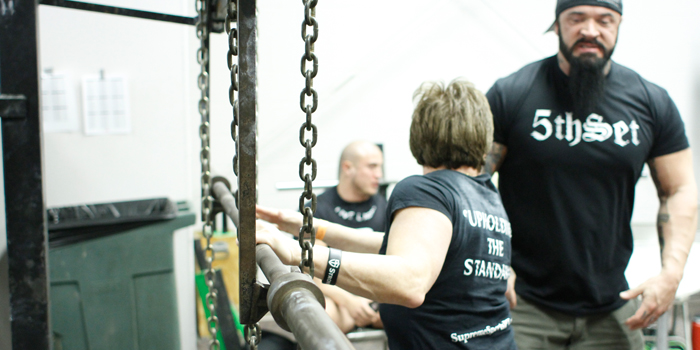
For those new to the sport of powerlifting, more specifically, competitive powerlifting, the warm-up area at a meet can be a tumultuous place. In my opinion, the warm-up room at a powerlifting meet is best described as controlled chaos. This is especially true if the meet is a large-scale meet.
A great example of this is the annual APF Illinois State Powerlifting Championships. This meet is typically a two-day affair and at the meet traditionally there are a couple hundred lifters competing. This particular annual meet I have competed many, many times, coached many times, and even hosted a few times back in the late 90s, early 2000s. This meet has a rich tradition and over the decades has been well attended. Being that Illinois is the land of Frantz powerlifting, it only makes sense that with the gravitas of the Frantz history to it and his impact on powerlifting in this state that the APF State Meet is a packed-house event.
This particular meet is now and has been for many years run by Eric and Jackie Stone as well as the APF’s secret weapon, Amy Jackson. Because of these three individuals, this particular meet runs like a well-oiled machine. Two days of multiple platforms, hundreds of lifters, and at the end of the weekend, the meet was virtually flawless with no misloads and no issues. The three meet directors control every and all of the competition variables, and no detail gets missed.
That, however, is the platform side of the meet. The warm-up area—now that is a totally different story. The warm-up area is something that is out of the control of the meet directors beyond the equipment that they might supply and their postings of flights and lifter orders.
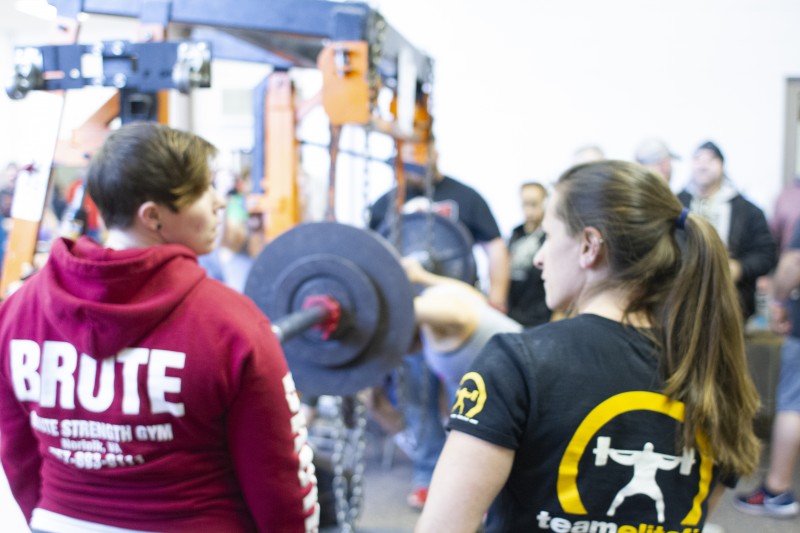
RELATED: 5 Things NOT To Do the Day of a Meet
The point is, no matter how perfectly a meet is run, the warm-up room is chaotic. It is a place where all the lifters go in mass, and it is a critical ingredient with regard to your success or failure at the meet. The warm-up area is where all of the lifters’ friends, the lifters’ buddies, the lifters’ pals, hangers-on, and frankly too many non-lifters who have no business in the warm-up room come to occupy. The warm-up area is the area where the vast majority of the meet’s lifters camp.
The warm-up area is packed full because there are always lifters warming up, there are always lifters waiting for their flights, lifters who have just lifted, lifters who are changing from squat suits to bench shirts or from their bench shirts to their deadlift suits, lifters who are eating in between flights, lifters who are talking strategy, lifters who are stretching out, or lifters just sitting there dejected after injuries or bombing out.
Larger meets like the aforementioned APF IL State Powerlifting Championships always have small groups of exceptional lifters competing at the meets. These are the lifters who are at the top of the pyramid and represent part of the backbone and stability of the APF in the state of Illinois. These powerlifters are at the top of the powerlifting food chain if you will. These are the chalk-laden warriors who make our sport and who have competed for years and in some cases for decades. These veteran powerlifters know exactly what they want to do in the meet, they know the protocol for the warm-up area and they are the skilled athletes that make meets like this worth coming to. They are the powerlifters using this state meet and similar meets as a warm-up or run-up to the big WPC and WPO meets. They are the successful, the pillars, the good examples for the newer lifters to emulate and learn from. They embody the mantra of “Live, Learn, and Pass On.”
Then, there are the newer-to-the-sport lifters at this meet. These are the lifters with little if any competitive experience that we welcome with open arms to the sport. But as welcome as they are, these are also the unintentional creators of the aforementioned chaos, part of the controlled chaos in the warm-up area.
To digress for a moment, the reason I mention state meets for the controlled chaos warm-up areas is that those are solid, often large meets and are often packed with newer lifters. It is at the more prestigious meets requiring given totals or placings, such as the WPC Worlds, the WPO meets, the APF Senior Nationals, and the like, that the more meet-savvy lifter, the more veteran lifter, the more polished lifter, the more experienced lifter competes in. As they have more road under their belts, those meets have far less overall chaos in the warm-up area.
It is when the newer-to-competition lifters come into the warm-up room that the room becomes chaotic. Once the chaos begins, the warm-up room can go from the warm-up area to free for all, and that is when tempers can flare. That is mostly happening with the more veteran lifters, who are now getting frustrated with the disorganized process, as it is interfering with their warm-ups. For those lifters, warm-ups are often critical lead-ups to attempts that can either break records or break the lifter.
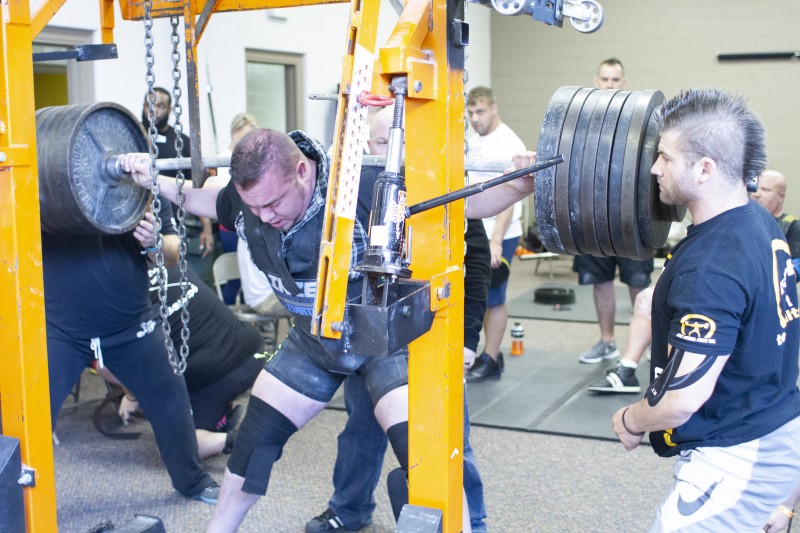
There are countless reasons for the disorganization in the warm-up room, and hopefully, some of this information will help those new or newer to the competition scene to survive in the warm-up area and benefit from it, as to how one’s warm-up go is often what sets the stage for the work that will come on the platform. Hopefully, this will also serve to provide a template of information that will keep that warm-up area a little more orderly, keep it safer, and keep the more pro lifters from having to blow their stacks when the newbie to the sport starts to unload the 900-pound bar to take some empty bar warm-ups as the pro lifter is getting his or her knees wrapped. If you have been around for a time, you have seen this all too many times.
For the newer person to the competitive aspect of sport lifter, to whom this article is addressed, warm-ups are the linchpin to success for nine attempts. If you get your timing wrong, you might not be warmed up enough, and you might end up having to make too large of a jump to get to your opener. And we all know that the body can, when warmed up properly, lift some 30 percent more than when lifting cold.
There are a number of warm-up area issues that can contribute to the chaos, and we will address some so that you can avoid these issues in your next meet’s warm-up area.
Something to keep in mind is that warm-up attempts in a warm-up room are a whole lot of “hurry up and wait.” Unlike your gym, where you can do a warm-up at your leisure, the warm-up room is a combination of getting work in when you can and keep an eye on either the clock if you are in the first flight, or the flight if you are not in the first flight. You need to be ready when the meet judges are ready to start the flight, and that means it is better to err on the side of over-warmed up (you can always rest after the squat and prior to the bench) than to not be warmed up enough. The more meets you do, the better you will be at your timing, but that will not be the case for your first few meets.
In the warm-up room, there will be some squat racks, and hopefully some monolifts, some plates, and some bars. As a newer-to-the-competitive-scene powerlifter, try to grab an area when you get to the warm-up room where you can easily get to your stuff and where you will camp in between flights. But make it not so much in the beaten path that everyone is trampling around you, your food, and your lifting gear, and basically getting in your way as you are in theirs.
With regard to the squat racks, bars, and weights in the warm-up area, try to find the one that best matches what you are going to do on the platform. If you are going to walk the weight out on the platform, don’t take up space in the warm-ups at a monolift.
For the been-there-done-that, 800+ pound squatters, they try to pick the best bar in the warm-up area. The bar they warm up with can make a difference in their warm-up lifts. Most warm-up rooms have those slick, whippy corporate gym bars, and one or two good Texas power bars. If you are a newer lifter, the bar will not matter so much for you. That said, if you are a newer lifter but you happen to squat 600 pounds or more, look for the better bars as well, or better yet, warm up with the stronger lifters so as not to waste time for the 200- to 500-pound lifters who have to wait for your larger weights to be loaded when the majority of them are all within a 50-pound span of one another.
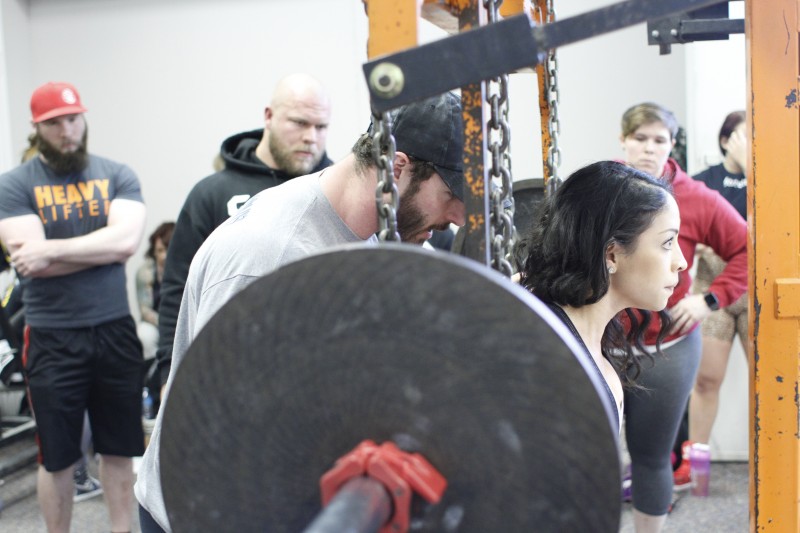
While you are choosing a barbell for your warm-up squats, grab collars, too. Meet warm-up areas seem to always lack enough collars. Remember that there are also people warming up on the bench for the bench-only portion of the meet, and that means more people warming up and using collars.
Take time to gather all of the plates you will need for your warm-ups. Having plates set up next to your squat rack means that you are not having to go search for plates while you and the other lifters are trying to get their warm-ups in. That said, once lifters are warming up at their racks, do not take weights from around their racks that they have gathered. In other words, be on time to the warm-up area, and don’t take plates from those in the throws of warming up. That is only going to cause conflict, and conflict in the warm-up area means attention goes from warming up to drama. Nobody wants that.
Know your warm-ups, and better yet, warm up during your meet prep at your gym like you will do at the meet. My personal advice is, if you can, warm up with 25s and 45s so that you are not needing 2s or 5s. Those little plates might as well be like gold in a warm-up area, as they are often rare finds and, like gold, just as precious. Bigger lifters will be fine with this, but if you are newer or still under that 400-pound squat threshold, you might have to grab those 2s and 5s. That means you need to get in that warm-up room on time or early and hunt them down and have them at your rack so that you can use them for your warm-ups.
With the warm-ups, look at the group of lifters sharing your warm-up rack. Either you or your handler can be assertive and get an order among that group, ask who is taking a plate, then who is taking a plate and a quarter, then who is taking two plates, and the process continues. Also, look at the caliber of the lifters around you. If you are a 148-pound novice lifter, avoid if at all possible warming up at a rack or monolift with the 275-pound lifters who are going to be lifting a lot more than you. This is for the benefit of you and those larger, strong(er) powerlifters.
If you are going to wrap your knees for a warm-up, be wrapping when the lifter in front of you is approaching the bar, as you want to be wrapped and ready when it is your time to warm up. This makes the warm-up room like a little mini-meet, where there is an order and where the weights go up until they need to come back down.
You should be prepared for that one lifter who will inevitably show up late to throw a wrench in the whole thing, and you should also not be that lifter. In my competitions, I have asked those late to the warm-up room to use other racks where the lifting is just starting or their weights are lower and the person can get in their 135, 185, 225, etc., on another rack rather than ruin the flow of your already established group has going. I am not saying to be rude or pushy or exclusionary, but realistically, if your group is at 500 pounds in the warm-ups and the new lifters want to take the empty bar, move them along or they can wait till there is a lull in the progression as the weight gets heavier. But by all means, do not be that lifter showing up late and wanting to stop the show for you.
While we are talking about the issues to avoid in the warm-up area, I have to include something that is a newer issue, and I almost can’t believe it has to be stated, but alas, it does. For God’s sake, keep your phone out of the warm-up room. Post, text, film, apply a filter, do all of that lemming and sheep and socialookatmedia stuff after the meet. The warm-up room and the platform are for the shepherds and lions of the sport. Stay in the moment, and pay attention, as the warm-up room has a life of its own, and the last thing you want to do is be slowed down by some socialookatmedia clown. That said, do not allow yourself to be that socialookatmedia clown that every other lifter warming up is waiting on. Know that if you are “that” lifter, the serious lifters already know that since you can’t stay off your phone, even on meet day, you are actually tonight's dinner for the serious lifters, and serious lifters love nice and tender mutton. So yeah, do not be that lifter in the weight room.
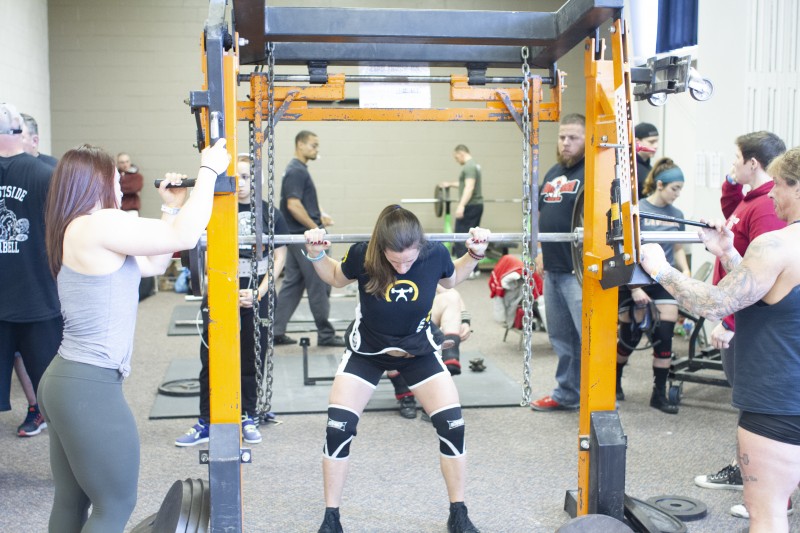
I tell my newer lifters the following: “Know your rack height in inches.” Here are the specifics in this article. The short version is this….after your heavy squat at the gym, measure the distance with a tape measure from the bottom of the barbell while it is still in the rack/monolift you just took your heavy squat from and measure down to the floor. That distance between the floor and the bottom of your barbell is your rack height in inches. Take your tape measure to the meet so instead of trying to guesstimate how low or high to make the squat rack pins or how low or high to set the monolift, just pull out that tape measure, and set the bar at your known and measured rack height and you are ready. Don’t cause delays trying to figure out the right height when others are ready to go.
Those who don’t measure ahead of time can wait forever in a long line, and when they get up to the bar and monolift, they can try to simulate where they think their stance is while dressed in sweats and under an empty bar. But you can walk up to that monolift, pull out your tape measure, have your exact inches of metal tape showing, bring the bar to that level of the tape, and glance over at the pinhole… done! You are off to warm up while the masses are in line for another 30 minutes. Even after their long 30 minutes, all they end up with is a best guess of where the bar should actually go. In other words, a mere approximation of that perfect bar setting that they have used so successfully at their gym for so very long. Make sense? So, measure your squat bar height so that you are not the lifter everyone is waiting on, and of equal importance, not the lifter wasting your own precious warm-up area time.
Just like in other social settings, there is a protocol involved when it comes to the warm-up area. The warm-up area works best when things are symbiotic, when they work together. As the new lifter, don’t be the “it’s all about me” lifter. If you have a bad lift, miss an attempt, the meet is not going your way, don’t be that lifter having a melt-down in the warm-up room. Keep your head in the game, or as “the kids say,” “Get over yourself.” If you made a mistake in the meet, you made the mistake, nobody else caused it, and they shouldn’t have to hear the residual meltdown. We all have made mistakes during a meet, and that is actually a learning opportunity so that you avoid that mistake at the big meets in the future. Pitching a fit only throws off the flow of the warm-up area and in the process you make yourself look like an armature. I say this not in a scolding tone, but with the intent to teach, as we have all been there. The powerlifting community is a small, tight-knit community, and there is no room for more drama or additional prima donnas or powerlifting divas. Trust me, this sport has them, but rarely do these folks know how ridiculous they look to the other lifters. So again, don’t be that lifter.
At the end of the day, think beyond yourself. If you are at a larger meet, lots of lifters mean lots of mess at the end of the day. Someone has to clean that up. If the meet is held at a high school, as they often are, the custodians along with the meet sponsors have to clean up after the mess. As you were part of this collective experience and as you are part of the powerlifting community and you helped contribute to the mess, then by all means, help clean up the warm-up area.
Once the squatting is over, those plates go onto the benches, then subsequently onto the deadlift bars. Help to strip those still loaded bars and put the weights away. Take that extra 10 minutes and clean up the area you and your friends were at. Chances are, trash was not being dumped during the meet as paying for weekend custodians is very expensive, so if the cans are full, pack up your garbage and take it with you and throw it away at home, or throw it away in another can that is not full somewhere else in the building.
If you made a mess with chalk or baby powder, or spilled something, don’t be that newbie who leaves his or her mess for others. Instead, try to leave the place how it was when you arrived, or maybe even a little bit better than when you arrived. Meet directors do a great job running the meet, but more often than not, they are also the folks who clean up the mess in the warm-up area. So, don’t be that lifter who leaves a mess for others to clean up.
Powerlifting is a community and the warm-up area is a social setting within that community and these are some things for you to consider as you prep for your first or first few powerlifting meets. Powerlifting is a journey, not a destination, and the sooner a lifter realizes this, the more successful he or she will be, and that helps not only the lifter but also this sport as a whole that we all love so very much.
Wishing you the best in your training and meet prep.










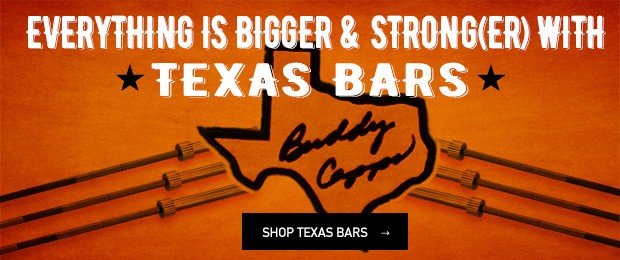
Warm ups are so essential and I learned the hard way. A few years ago at WPC Worlds I only deadlifted. When the guys benching were finished they told us we would have 45 minutes to warm up for the deadlift. 15 minutes later they called the first lifter. I wasn't close to being ready, got my first attempt, and then ripped my left lat right off my shoulder on my second attempt and was done for the day (and a year). I learned that I have to give myself plenty of time to warm up no matter what the meet directors say. On top of that, the room the meet was taking place in was so cold you could've hung a side of beef in it. Since then and from now on, I don't care if the meet takes place on the equator, I bring a sweatshirt to wear during warm ups.